Shallow Landslides Physically Based Susceptibility Assessment Improvement Using InSAR. Case Study: Carpathian and Subcarpathian Prahova Valley, Romania
Abstract
1. Introduction
2. Tectonic and Geological Settings of the Study Area
3. Data and Modelling Parameters
3.1. Spatial Database and Input Parameters
- Granulometry analysis;
- Natural moisture analysis (w);
- Plasticity analysis—Atterberg limits (liquid limit WL, plastic limit WP, consistency index IC, plasticity index IP);
- Structure index analysis (moist volumetric weight γ, dry volumetric weight γd, voids index e, porosity n);
- Monoaxial compression resistance (compression resistance Rc).
3.2. InSAR Data
4. Slope Stability Assessment Methods
4.1. The Infinite Slope Model
4.2. InSAR Based Method
5. Modelling Results
5.1. Deterministic Approach
5.2. InSAR Results
6. Validation Procedure
6.1. The Prediction-Rate Curve
6.2. Comparison between Susceptibility Map and InSAR Detected Landslides
7. Discussions and Conclusions
Author Contributions
Funding
Institutional Review Board Statement
Informed Consent Statement
Data Availability Statement
Acknowledgments
Conflicts of Interest
References
- Varnes, D.J. Slope movement types and processes. In Special Report 176: Landslides: Analysis and Control; Schuster, R.L., Krizek, R.J., Eds.; Transportation and Road Research Board, National Academy of Science: Washington, DC, USA, 1978; pp. 11–33. [Google Scholar]
- Geografia României, I. Geografi a Fizică (Geography of Romania, I. Physical Geography); Edit. Academiei: Bucureşti, Romania, 1983; pp. 171–194. (In Romanian) [Google Scholar]
- Bălteanu, D. Romania. In Geomorphological Hazards of Europe; Embelton, C., Embelton-Hamann, C., Eds.; Elsevier: Amsterdam, The Netherlands, 1997; pp. 409–427. [Google Scholar]
- Micu, M.; Bălteanu, D. Landslide hazard assessment in the Bend Carpathians and Subcarpathians, Romania. Z. Geomorphol. 2009, 53 (Suppl. 3), 49–64. [Google Scholar] [CrossRef]
- Micu, M.; Sima, M.; Bălteanu, D.; Micu, D.; Dragotă, C.; Chendeş, V. A multi-hazard assessment in the Curvature Carpathians of Romania. In Mountain Risks: Bringing Science to Society; Malet, J.-P., Glade, T., Casagli, N., Eds.; CERG Editions: Strasbourg, Germany, 2010; pp. 11–18. [Google Scholar]
- Bălteanu, D.; Jurchescu, M.; Surdeanu, V.; Ionita, I.; Goran, C.; Urdea, P.; Rădoane, M.; Rădoane, N.; Sima, M. Recent landform evolution in the Romanian Carpathians and Pericarpathian Regions. In Recent Landform Evolution: The Carpatho–Balkan–Dinaric Region; Lóczy, D., Stankoviansky, M., Kotarba, A., Eds.; Springer Geography: Berlin/Heidelberg, Germany, 2012. [Google Scholar] [CrossRef]
- Bălteanu, D. The importance of mass movements in the Romanian Subcarpathians. Z. Fur Geomorphol. 1986, 58, 173–190. [Google Scholar]
- Armaş, I.; Damian, R.; Sandric, I.; Osaci-Costache, G. Vulnerabilitatea Versantilor Subcarpatici la Alunecari de Teren (Valea Prahovei); Editura Fundatiei Romania de Maine: Bucharest, Romania, 2003. [Google Scholar]
- Surdeanu, V. La repartition des glissements de terrain dans le Carpates Orientales (zone du flysch). Geogr. Fis. Din. Quat. 1996, 19, 265–271. [Google Scholar]
- Wieczorek, G.F. Preparing a detailed landslide-inventory map for hazard evaluation and reduction. Bull. Assoc. Eng. Geol. 1984, 21, 337–342. [Google Scholar] [CrossRef]
- Van Westen, C.J.; Castellanos, E.; Kuriakose, S.L. Spatial data for landslide susceptibility, hazard, and vulnerability assessment: An overview. Eng. Geol. 2008, 102, 112–131. [Google Scholar] [CrossRef]
- Brabb, E.E. Innovative approaches to landslide hazard and risk mapping. In Proceedings of the 4th International Symposium on Landslides, Toronto, ON, Canada, 16–21 September 1984; Volume 1, pp. 307–324. [Google Scholar]
- Van Westen, J. Landslide Hazard. Zonation: A Review with Examples from the Colombian Andes; Price, M.F., Heywood, D.I., Eds.; Taylor and Francis: London, UK, 1994; pp. 135–165. [Google Scholar]
- Guzzetti, F.; Carrara, A.; Cardinali, M.; Reichenbach, P. Landslide hazard evaluation: A review of current techniques and their application in a multi-scale study, Central Italy. Geomorphology 1999, 31, 181–216. [Google Scholar] [CrossRef]
- Carson, M.A.; Kirkby, M.J. Hillslope Form and Process; Cambridge University Press: London, UK, 1972. [Google Scholar]
- Crozier, M.J. Landslides: Causes Consequences and Environment; Croom Helm: London, UK, 1986. [Google Scholar]
- Aleotti, P.; Chowdhury, R. Landslide hazard assessment: Summary review and new perspectives. Bull. Eng. Geol. Environ. 1999, 58, 21–44. [Google Scholar] [CrossRef]
- Duncan, J.M.; Wright, S.G. Soil Strength and Slope Stability; Wiley: Hoboken, NJ, USA, 2005. [Google Scholar]
- Van Westen, C.J. The modelling of landslide hazards using GIS. Surv. Geophys. 2000, 21, 241–255. [Google Scholar] [CrossRef]
- Guzzetti, F. Landslide Hazard and Risk Assessment. Ph.D. Thesis, University of Bonn, Bonn, Germany, 2000. [Google Scholar]
- Van Westen, C.J.; Van Asch, T.W.J.; Soeters, R. Landslide hazard and risk zonation–Why is it still so difficult? Bull. Eng. Geol. Environ. 2006, 65, 167–184. [Google Scholar] [CrossRef]
- Van Westen, C.J.; Terlien, T.J. An approach towards deterministic landslide hazard analysis in GIS. A case study from Manizales (Colombia). Earth Surf. Process. Landf. 1996, 21, 853–868. [Google Scholar] [CrossRef]
- Sharma, S. Slope Stability Concepts. In Slope Stability and Stabilization Methods; Abramson, L.W., Lee, T.S., Sharma, S., Boyce, G.M., Eds.; John Wiley & Sons, Inc.: New York, NY, USA, 2002; pp. 329–461. [Google Scholar]
- Cruden, D.M.; Varnes, D.J. Landslides: Investigation and mitigation. Chapter 3-Landslide types and processes. In Transportation Research Board Special Report; National Academy Press: Washington, DC, USA, 1996; p. 247. [Google Scholar]
- Lu, N.; Godt, J.W. Hillslope Hydrology and Stability; Cambridge University Press: Cambridge, UK, 2013. [Google Scholar]
- Dietrich, W.E.; Bellugi, D.; De Asua, R. Validation of the shallow landslide model, SHALSTAB, for forest management. In Land Use and Watersheds: Human Influence on Hydrology and Geomorphology in Urban and Forest Areas; Wigmosta, M.S., Burges, S.J., Eds.; American Geophysical Union: Washington, DC, USA, 2001; pp. 195–227. [Google Scholar]
- Borga, M.; Dalla Fontana, G.; Gregoretti, C.; Marchi, L. Assessment of shallow landsliding by using a physically based model of hillslope stability. Hydrol. Process. 2002, 16, 2833–2851. [Google Scholar] [CrossRef]
- Huang, J.-C.; Kao, S.-J.; Hsu, M.-L.; Liu, Y.-A. Influence of Specific Contributing Area algorithms on slope failure prediction in landslide modeling. Nat. Hazards Earth Syst. Sci. 2007, 7, 781–792. [Google Scholar] [CrossRef]
- Frattini, P.; Crosta, G.B.; Fusi, N.; Dal Negro, P. Shallow landslides in pyroclastic soils: A distributed modelling approach for hazard assessment. Eng. Geol. 2004, 73, 277–295. [Google Scholar] [CrossRef]
- Rosso, R.; Rulli, M.C.; Vannucchi, G. A physically based model for the hydrologic control on shallow landsliding. Water Res. 2006, 42, 6410. [Google Scholar] [CrossRef]
- Godt, J.W.; Baum, R.L.; Savage, W.Z.; Salciarini, D.; Schulz, W.H.; Harp, E.L. Transient deterministic shallow landslide modeling: Requirements for susceptibility and hazard assessments in a GIS framework. Eng. Geol. 2008, 102, 214–226. [Google Scholar] [CrossRef]
- D’Amato Avanzi, G.; Falaschi, F.; Giannecchini, R.; Puccinelli, A. Soil slip susceptibility assessment using mechanical-hydrological approach and GIS techniques: An application in the Apuan Alps (Italy). Nat. Hazards 2009, 50, 591–603. [Google Scholar] [CrossRef]
- Ho, J.Y.; Lee, K.T.; Chang, T.C.; Wang, Z.Y.; Liao, Y. Influences of spatial distribution of soil thickness on shallow landslide prediction. Eng. Geol. 2012, 124, 38–46. [Google Scholar] [CrossRef]
- Alvioli, M.; Guzzetti, F.; Rossi, M. Scaling properties of rainfall induced landslides predicted by a physically based model. Geomorphology 2014, 213, 38–47. [Google Scholar] [CrossRef]
- Armaş, I.; Vartolomei, F.; Stroia, F.; Brasovanu, L. Landslide susceptibility deterministic approach using geographical information systems: Application to Breaza city, Romania. Nat. Hazards 2014, 70, 995–1017. [Google Scholar] [CrossRef]
- Bürgmann, R.; Rosen, P.A.; Fielding, E.J. Synthetic aperture radar interferometry to measure Earth’s surface topography and its deformation. Annu. Rev. Earth Planet. Sci. 2000, 28, 169–209. [Google Scholar] [CrossRef]
- Colesanti, C.; Wasowski, J. Investigating landslides with space-borne Synthetic Aperture Radar (SAR) interferometry. Eng. Geol. 2006, 88, 173–199. [Google Scholar] [CrossRef]
- Dammert, P.B. Accuracy of INSAR measurements in forested areas. In Proceedings of the Fringe 96 Workshop, Zurich, Switzerland, 30 September–2 October 1996; Volume 406, pp. 37–45. [Google Scholar]
- Ferretti, A.; Savio, G.; Barzaghi, R.; Borghi, A.; Musazzi, S.; Novali, F.; Prati, C.; Rocca, F. Submillimeter accuracy of InSAR time series: Experimental validation. IEEE Trans. Geosci. Remote Sens. 2007, 45, 1142–1153. [Google Scholar] [CrossRef]
- Torres, R.; Snoeij, P.; Geudtner, D.; Bibby, D.; Davidson, M.; Attema, E.; Potin, P.; Rommen, B.; Floury, N.; Brown, M.; et al. GMES Sentinel-1 mission. Remote Sens. Environ. 2012, 120, 9–24. [Google Scholar] [CrossRef]
- Ferretti, A.; Prati, C.; Rocca, F. Non-linear subsidence rate estimation using permanent scatterers in differential SAR interferometry. IEEE Trans. Geosci. Remote Sens. 2000, 38, 2202–2212. [Google Scholar] [CrossRef]
- Ferretti, A.; Prati, C.; Rocca, F. Permanent scatterers in SAR interferometry. IEEE Trans. Geosci. Remote Sens. 2001, 39, 8–20. [Google Scholar] [CrossRef]
- Farina, P.; Colombo, D.; Fumagalli, A.; Marks, F.; Moretti, S. Permanent Scatterers for landslide investigations: Outcomes from the ESA-SLAM project. Eng. Geol. 2006, 88, 200–217. [Google Scholar] [CrossRef]
- Motagh, M.; Wetzel, H.-U.; Roessner, S.; Kaufmann, H. A TerraSAR-X InSAR study of landslides in southern Kyrgyzstan, central Asia. Remote Sens. Lett. 2013, 4, 657–666. [Google Scholar] [CrossRef]
- Hölbling, D.; Füreder, P.; Antolini, F.; Cigna, F.; Casagli, N.; Lang, S. A semi-automated object-based approach for landslide detection validated by persistent scatterer interferometry measures and landslide inventories. Remote Sens. 2012, 4, 1310–1336. [Google Scholar] [CrossRef]
- Righini, G.; Pancioli, V.; Casagli, N. Updating landslide inventory maps using Persistent Scatterer Interferometry (PSI). Int. J. Remote Sens. 2012, 33, 2068–2096. [Google Scholar] [CrossRef]
- Berardino, P.; Fornaro, G.; Lanari, R.; Sansosti, E. A new algorithm for surface deformation monitoring based on small baseline differential SAR interferometry. IEEE Aerosp. Electron. 2002, 40, 2375–2383. [Google Scholar]
- Zhao, C.; Zhong, L.; Zhang, Q.; de La Fuente, J. Large-area landslide detection and monitoring with ALOS/PALSAR imagery data over Northern California and Southern Oregon, USA. Remote Sens. Environ. 2012, 124, 348–359. [Google Scholar] [CrossRef]
- Liu, P.; Li, Z.; Hoey, T.; Kincal, C.; Zhang, J.; Zeng, Q.; Muller, J.P. Using advanced InSAR time series techniques to monitor landslide movements in Badong of the Three Gorges region. China. Int. J. Appl. Earth Obs. Geoinf. 2013, 21, 253–264. [Google Scholar] [CrossRef]
- Cascini, L.; Fornaro, G.; Peduto, D. Advanced low-and full-resolution DInSAR map generation for slow-moving landslide analysis at different scales. Eng. Geol. 2010, 112, 29–426. [Google Scholar] [CrossRef]
- Cascini, L.; Peduto, D.; Pisciotta, G.; Arena, L.; Ferlisi, S.; Fornaro, G. The combination of DInSAR and facility damage data for the updating of slow-moving landslide inventory maps at medium scale. Nat. Hazards Earth Syst. Sci. 2013, 13, 1527. [Google Scholar] [CrossRef]
- Bateson, L.; Cigna, F.; Boon, D.; Sowter, A. The application of the Intermittent SBAS (ISBAS) InSAR method to the South Wales Coalfield, UK. Int. J. Appl. Earth Obs. Geoinf. 2015, 34, 249–257. [Google Scholar] [CrossRef]
- Bianchini, S.; Cigna, F.; Righini, G.; Proietti, C.; Casagli, N. Landslide hotspot mapping by means of persistent scatterer interferometry. Environ. Earth Sci. 2012, 67, 1155–1172. [Google Scholar] [CrossRef]
- Tantianuparp, P.; Shi, X.; Zhang, L.; Balz, T.; Liao, M. Characterization of landslide deformations in three gorges area using multiple InSAR data stacks. Remote Sens. 2013, 5, 2704–2719. [Google Scholar] [CrossRef]
- Bozzano, F.; Mazzanti, P.; Perissin, D.; Rocca, A.; De Pari, P.; Discenza, M.E. Basin scale assessment of landslides geomorphological setting by advanced InSAR analysis. Remote Sens. 2017, 9, 267. [Google Scholar] [CrossRef]
- Dai, K.; Li, Z.; Tomás, R.; Liu, G.; Yu, B.; Wang, X.; Stockamp, J. Monitoring activity at the Daguangbao mega-landslide (China) using Sentinel-1 TOPS time series interferometry. Remote Sens. Environ. 2016, 186, 501–513. [Google Scholar] [CrossRef]
- Intrieri, E.; Raspini, F.; Fumagalli, A.; Lu, P.; Del Conte, S.; Farina, P.; Allievi, J.; Ferretti, A.; Casagli, N. The Maoxian landslide as seen from space: Detecting precursors of failure with Sentinel-1 data. Landslides 2018, 15, 123–133. [Google Scholar] [CrossRef]
- Béjar-Pizarro, M.; Notti, D.; Mateos, R.M.; Ezquerro, P.; Centolanza, G.; Herrera, G.; Bru, G.; Sanabria, M.; Solari, L.; Duro, J.; et al. Mapping vulnerable urban areas affected by slow-moving landslides using Sentinel-1 InSAR data. Remote Sens. 2017, 9, 876. [Google Scholar] [CrossRef]
- Bardi, F.; Raspini, F.; Ciampalini, A.; Kristensen, L.; Rouyet, L.; Lauknes, T.; Frauenfelder, R.; Casagli, N. Space-borne and ground-based InSAR data integration: The Åknes test site. Remote Sens. 2016, 8, 237. [Google Scholar] [CrossRef]
- Necula, N.; Niculiță, M.; Tessari, G.; Floris, M. InSAR analysis of Sentinel-1 data for monitoring landslide displacement of the north-eastern Copou hillslope, Iași city, Romania. In Proceedings of the Romanian Geomorphology Symposium, Iași, Romania, 11–14 May 2017; Volume 1, pp. 85–88. [Google Scholar]
- Armaş, I.; Gogoașe Nistoran, D.; Osaci-Costache, G.; Brașoveanu, L. Morpho-Dynamic Evolution Patterns of Subcarpathian Prahova River (Romania). Catena 2013, 100, 83–99. [Google Scholar] [CrossRef]
- Ştefănescu, M.; Mărunţeanu, M. Age of the Doftana Molasse, Dări de Seamă ale Şedinţelor; Institututl Geologic al Romaniei: Bucuresti, Romania, 1980; Volume LXV/4, pp. 169–182. [Google Scholar]
- Săndulescu, M. Geotectonica României; Editura Tehnică: Bucharest, Romania, 1984. [Google Scholar]
- Ştefănescu, M. Stratigraphy and structure of cretaceous and paleogene flysch deposits between Prahova and Ialomiţa valleys. Rom. J. Tecton. Reg. Geol. 1995, 76, 3–49. [Google Scholar]
- Armaş¸, I. Bazinul Hidrografic Doftana. Studiu de Geomorfologie; Ed. Enciclopedică: Bucharest, Romania, 1999; p. 240. [Google Scholar]
- Armaş, I.; Damian, R.; Stroia, F. The Vulnerability of Scarps Caused by Anthropic Impact. Case Study: The Breaza Terrace Scarp-The Prahova Valley. Present Environ. Sustain. Dev. 2007, 1, 179–191. [Google Scholar]
- Armaş, I.; Damian, R.; Sandric, I. Landslides in the M. Căproiu St.- Eternității St. perimeter, town of Breaza. Rev. Geomorfol. 2004, VI, 61–71. [Google Scholar]
- Armaş, I.; Damian, R. Evolutive Interpretation of the Landslides from the Miron Căproiu Street Scarp (Eternităţii Street– V. Alecsandri Street)–Breaza Town. Rev. Geomorfol. 2006, VIII, 65–72. [Google Scholar]
- Beek, L.P.H. Van Assessment of the Influence of Changes in Landuse and Climate on Landslide Activity in a Mediterranean Environment. Ph.D. Thesis, Utrecht University, Utrecht, Germany, 2002. [Google Scholar]
- Mergili, M.; Marchesini, I.; Alvioli, M.; Metz, M.; Schneider-Muntau, B.; Rossi, M.; Guzzetti, F. A strategy for GIS-based 3-D slope stability modelling over large areas. Geosci. Model. Dev. 2014, 7, 2969–2982. [Google Scholar] [CrossRef]
- Brunsden, D.; Prior, D.B. Slope Stability; Wiley: Hoboken, NJ, USA, 1984; p. 620. [Google Scholar]
- Ardeleanu, L.; Leydecker, G.; Bonjer, K.P.; Busche, H.; Kaiser, D.; Schmitt, T. Probabilistic seismic hazard map for Romania as a basis for a new building code. Nat. Hazards Earth Syst. Sci. 2005, 5, 679–684. [Google Scholar] [CrossRef]
- Mărmureanu, G.; Cioflan, C.O.; Mărmureanu, A. New approach on seismic hazard isoseismal map for Romania. Rom. Rep. Phys. 2008, 60, 1123–1135. [Google Scholar]
- Costantini, M.; Rosen, P.A. A generalized phase unwrapping approach for sparse data. In Proceedings of the IEEE 1999 International Geoscience and Remote Sensing Symposium, Hamburg, Germany, 28 June–2 July 1999; Volume 1, pp. 267–269. [Google Scholar]
- Istrate, A. The role of the tectonic factor in the distribution of the landslides in the Carpathian flysch from the Ialomita basin. In Forum Geografic (No. 4); Department of Geography, University of Craiova: Craiova, Romania, 2005; p. 26. [Google Scholar]
- Sidle, R.C. Relative importance of factors influencing landsliding in coastal Alaska. In Proceedings of the 21st Annual Engineering, Geology and Soil Engineering Symposium, Moscow, ID, USA, 5–6 April 1984; University of Idaho: Idaho, Moscow, USA; pp. 311–325. [Google Scholar]
- Chang, H.; Kim, N.K. The evaluation and the sensitivity analysis of GIS-based landslide susceptibility models. Geosci. J. 2004, 8, 415–423. [Google Scholar] [CrossRef]
- Crosta, G.B.; Frattini, P. Distributed modelling of shallow landslides triggered by intense rainfall. Nat. Hazards Earth Syst. Sci. 2003, 3, 81–93. [Google Scholar] [CrossRef]
- Pratesi, F.; Tapete, D.; Terenzi, G.; Del Ventisette, C.; Moretti, S. Rating health and stability of engineering structures via classification indexes of InSAR Persistent Scatterers. Int. J. Appl. Earth Obs. Geoinf. 2015, 40, 81–90. [Google Scholar] [CrossRef]
- Chung, C.F.; Fabbri, A.G. Validation of spatial prediction models for landslide hazard mapping. Nat. Hazards 2003, 30, 451–472. [Google Scholar] [CrossRef]
- Vázquez-Selem, L.; Zinck, A.J. Modeling gully distribution on volcanic terrains in the Huasca area, central Mexico. ITC J. 1994, 3, 238–251. [Google Scholar]
- Zinck, J.A.; López, J.; Metternicht, G.I.; Shrestha, D.P.; Vázquez-Selem, L. Mapping and modelling mass movements and gullies in mountainous areas using remote sensing and GIS techniques. Int. J. Appl. Earth Obs. Geoinf. 2001, 3, 43–53. [Google Scholar] [CrossRef]
- Ferretti, A.; Fumagalli, A.; Novali, F.; Prati, C.; Rocca, F.; Rucci, A. A new algorithm for processing interferometric data-stacks: SqueeSAR. IEEE Trans. Geosci. Remote Sens. 2011, 49, 3460–3470. [Google Scholar] [CrossRef]
- Meisina, C.; Notti, D.; Zucca, F.; Ceriani, M.; Colombo, A.; Poggi, F.; Roccati, A.; Zaccone, A. The use of PSInSAR™ and SqueeSAR™ techniques for updating landslide inventories. In Landslide Science and Practice; Springer: Berlin/Heidelberg, Germany, 2013; pp. 81–87. [Google Scholar]
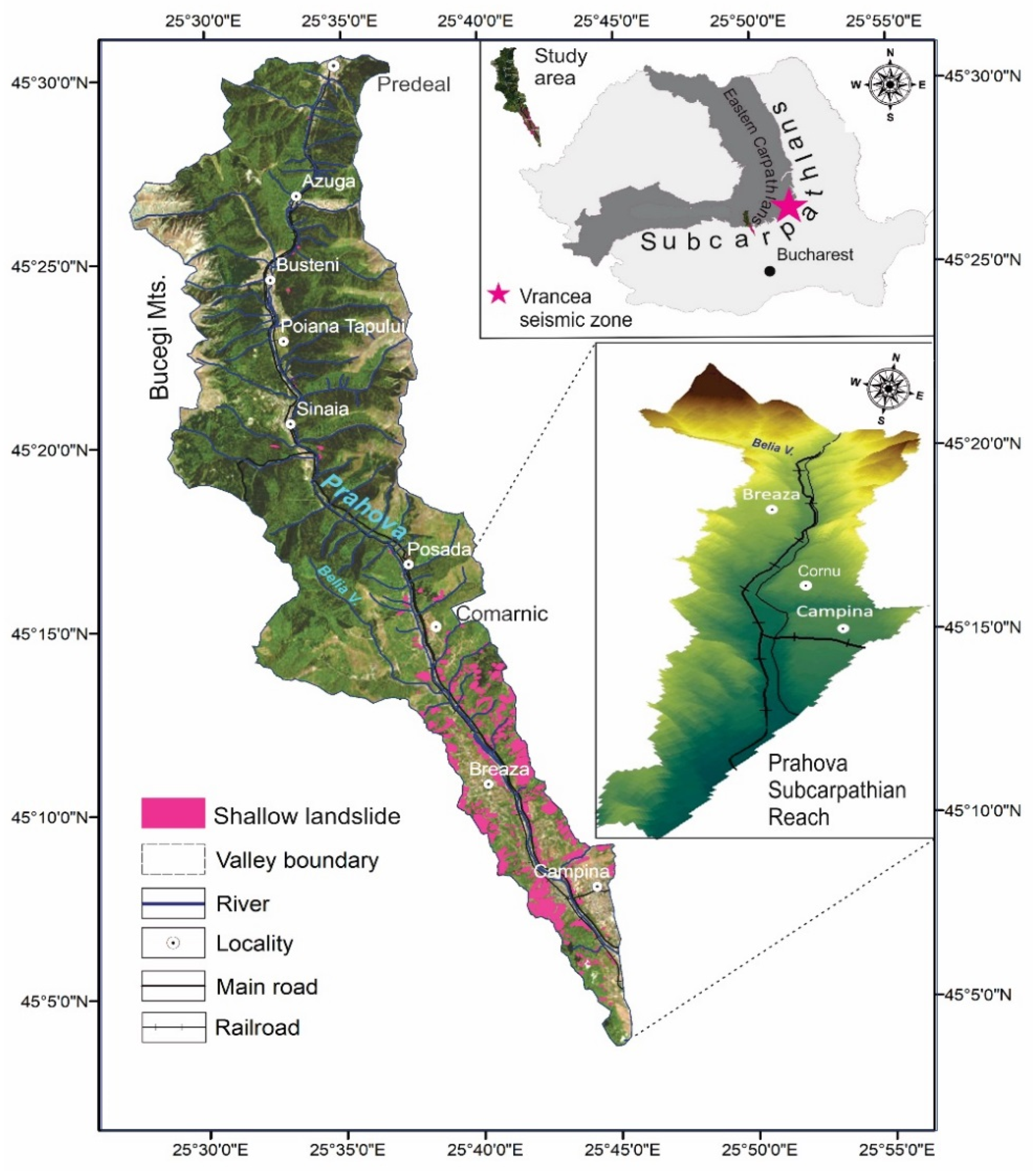


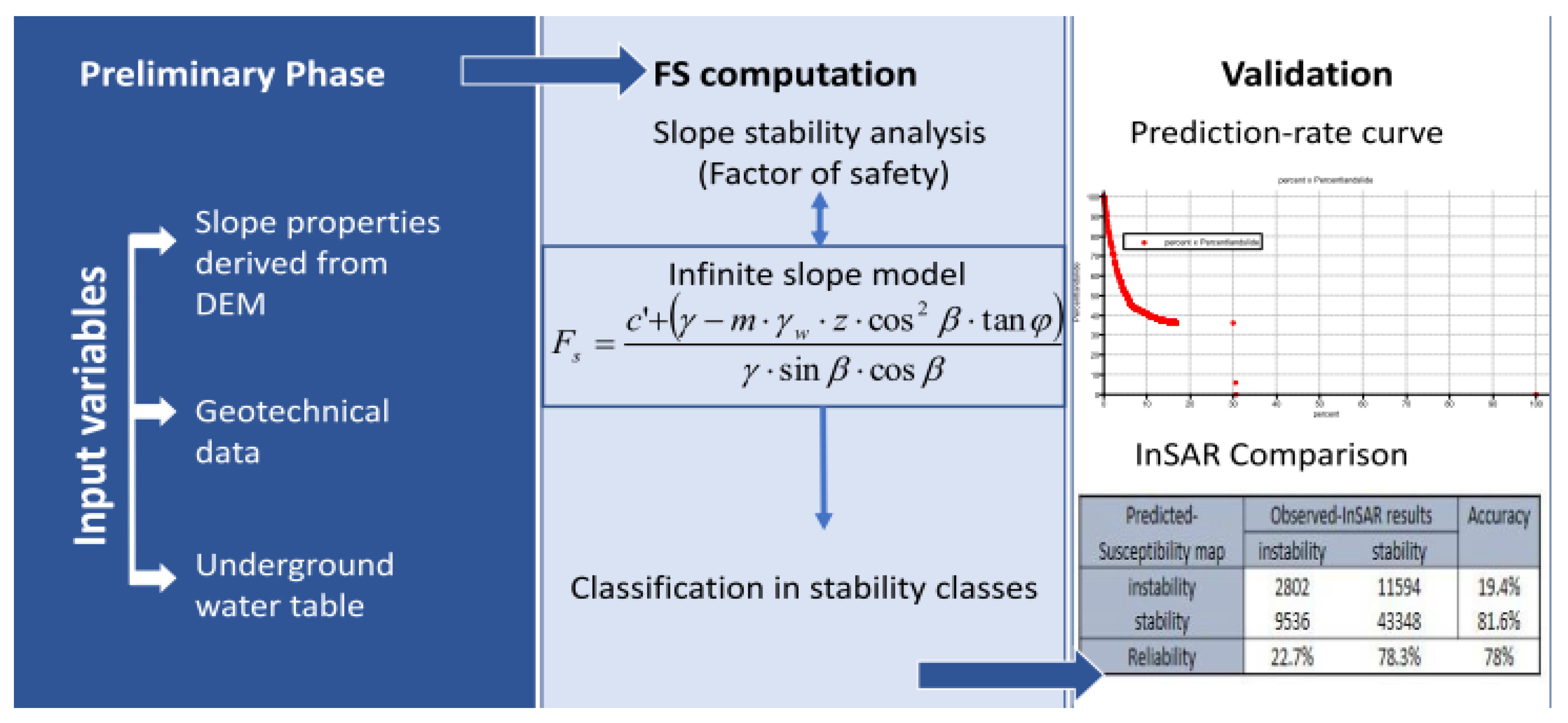
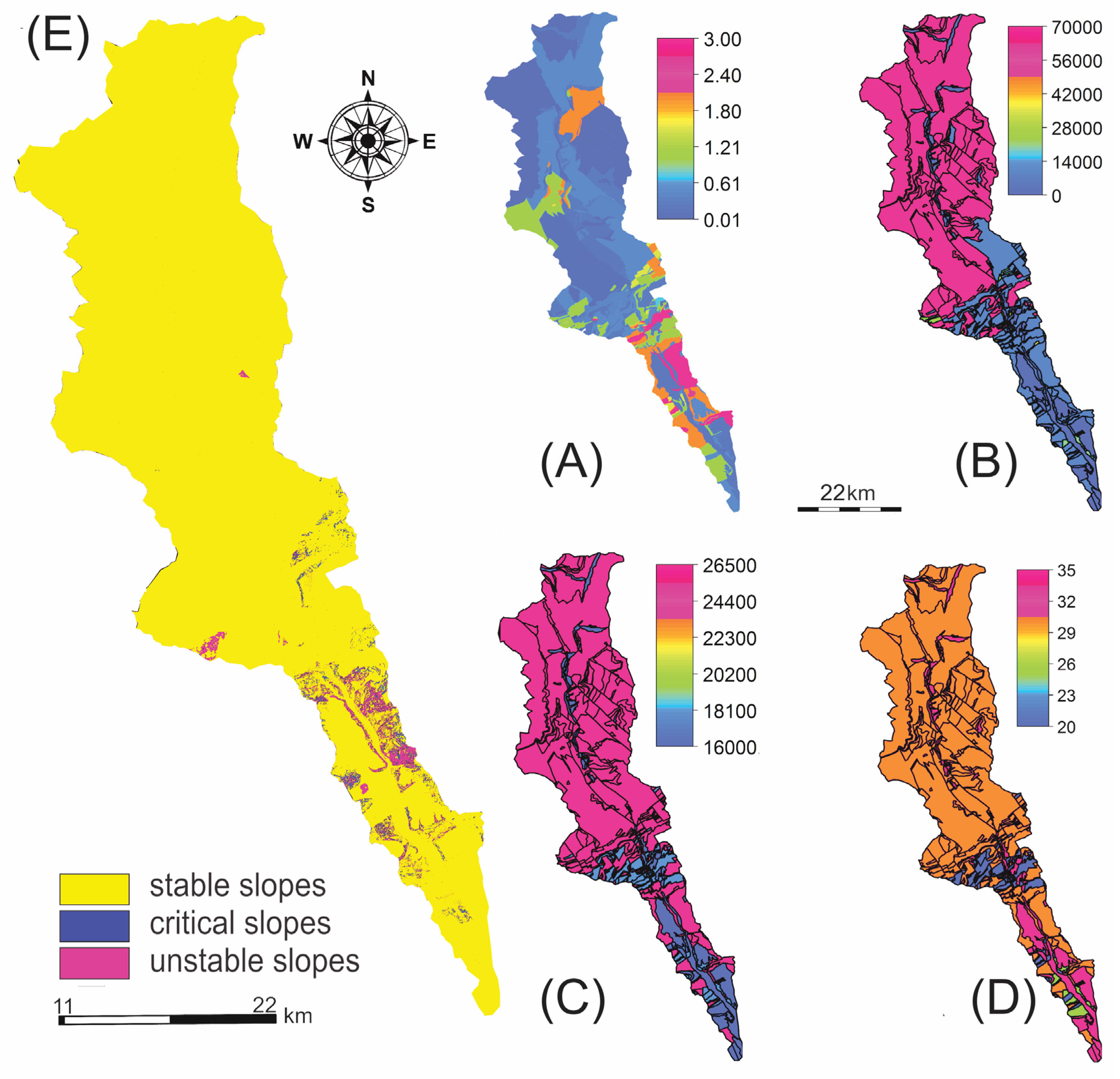
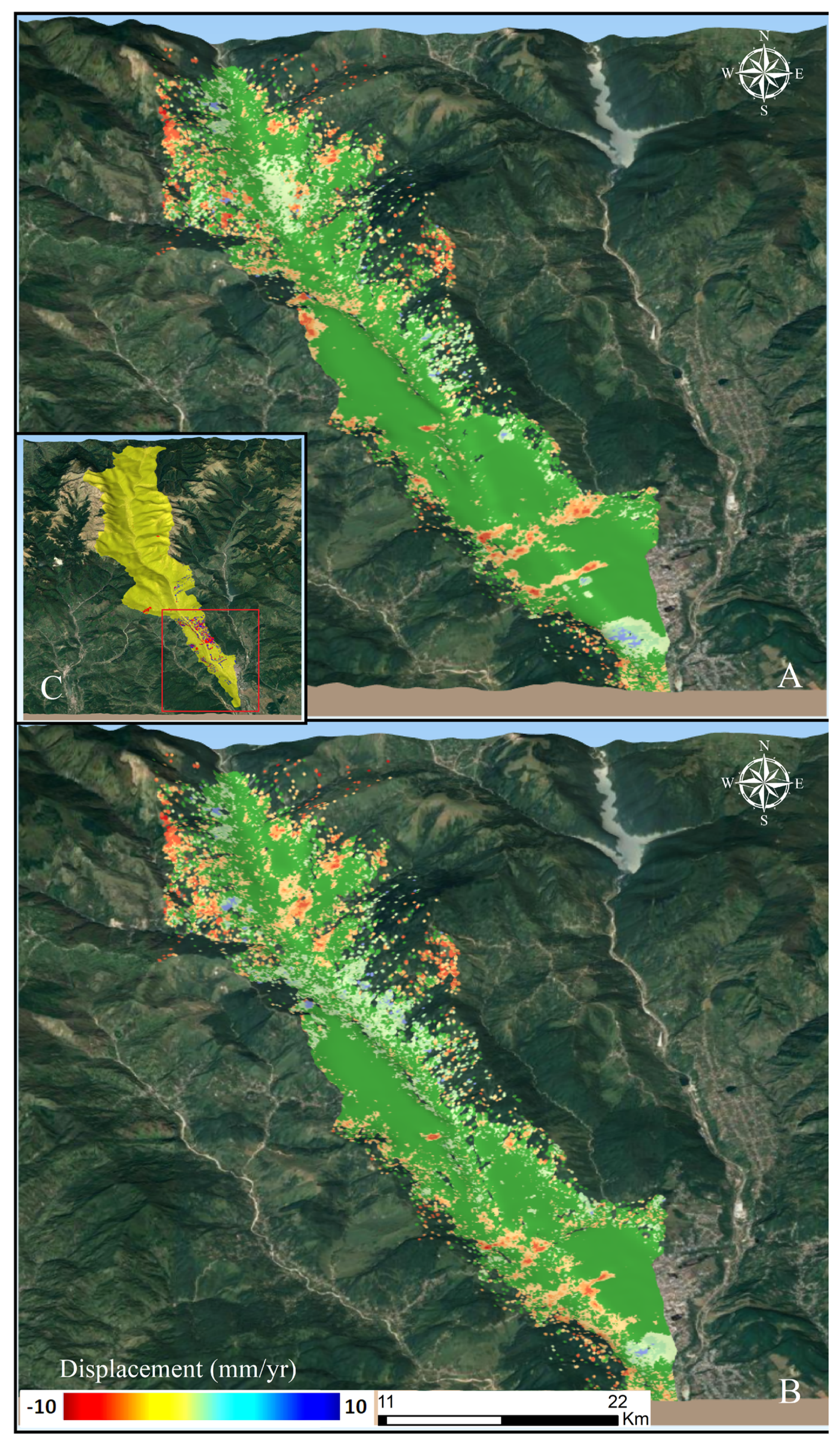
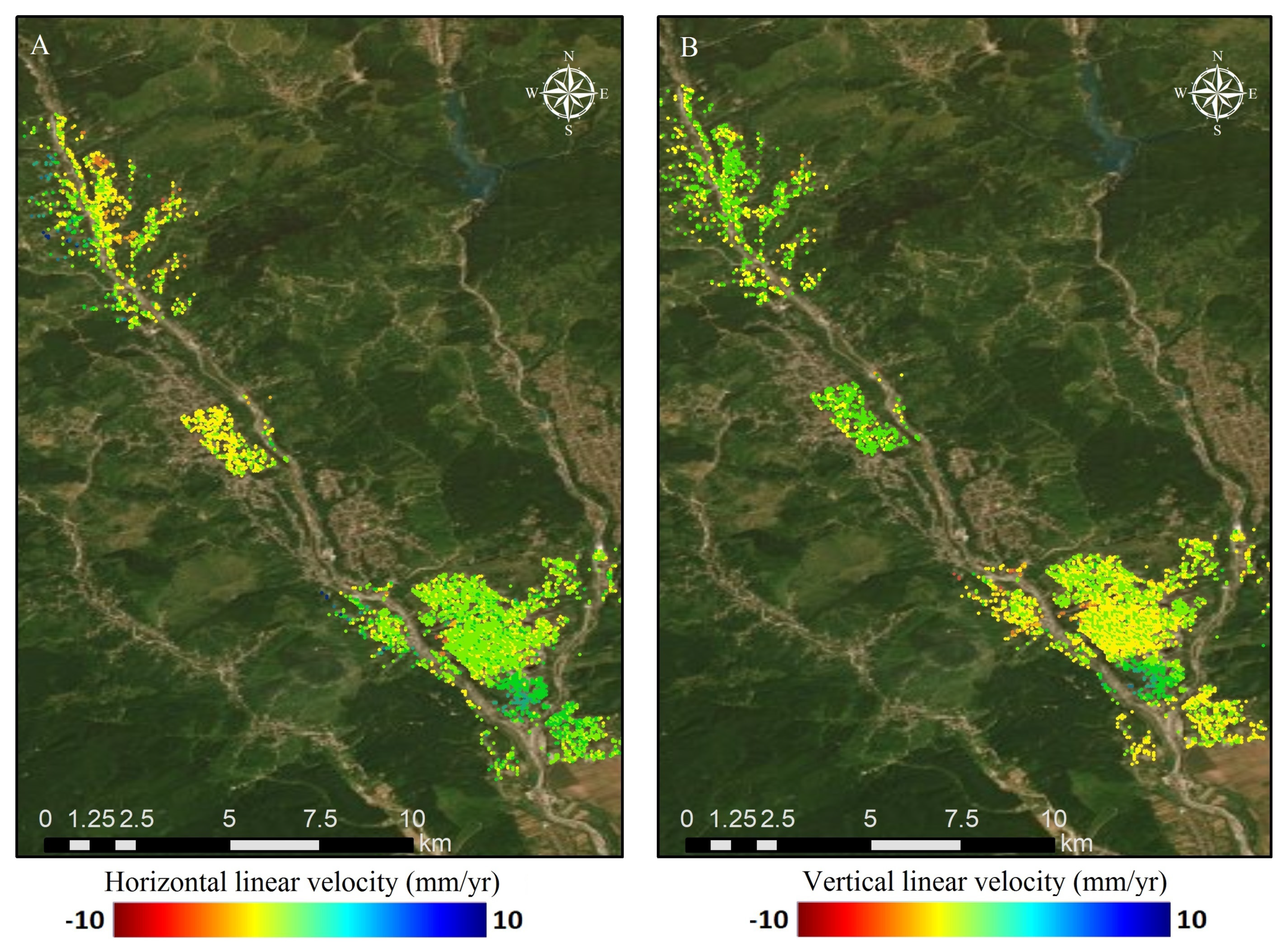
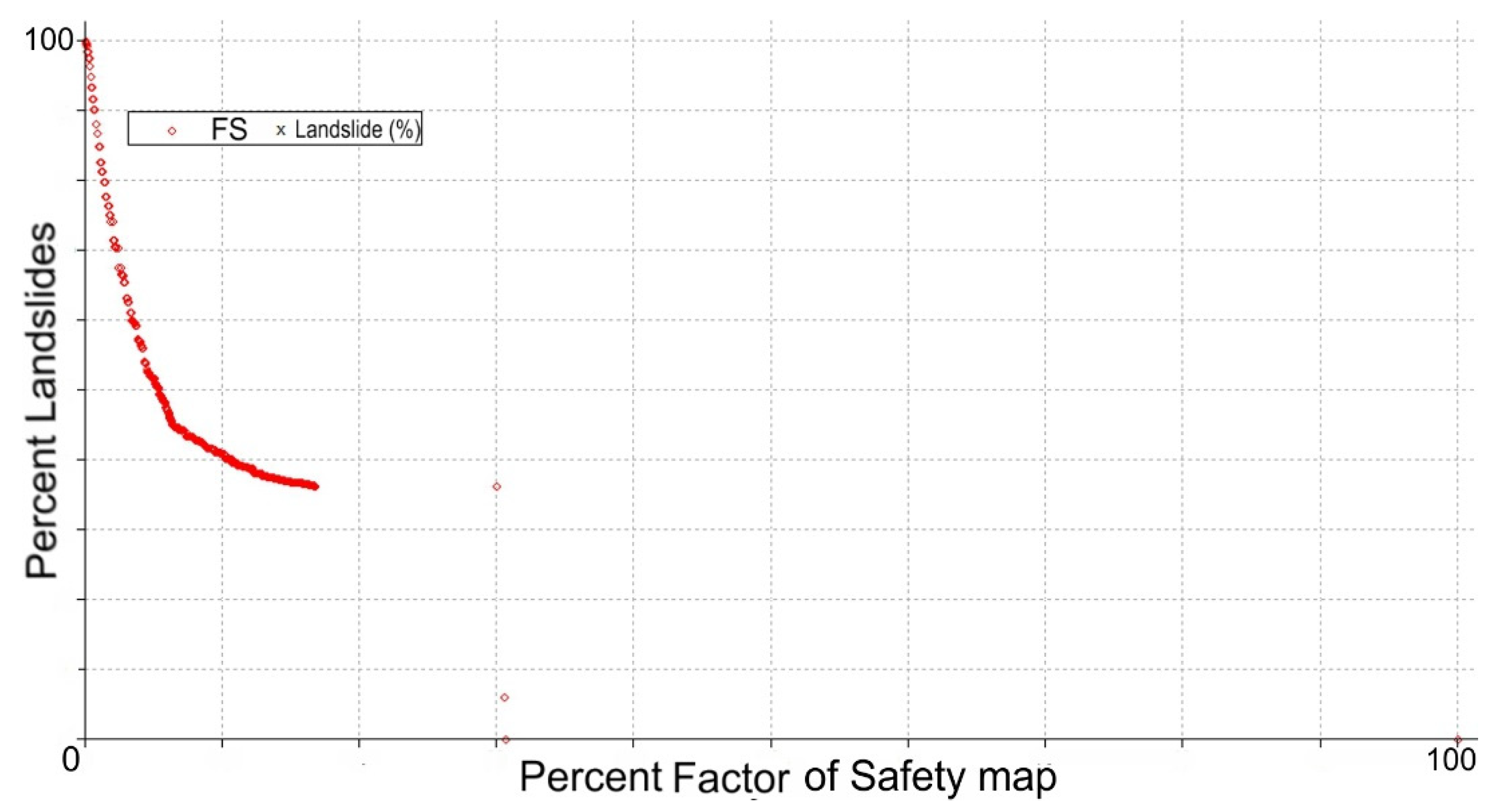


| Stage/Age | Series/Epoch | Classes | Cohesion [Pa] | Friction Angle [°] | Unit Weight [N/m3] |
|---|---|---|---|---|---|
| Undifferentiated on the geologic map in Figure 2 | Pleistocene and Holocene | Sand + gravel | 0 | 40 | 15,000–16,000 |
| Romanian | Pliocene | Clay + sand + marl | 10,000–35,000 | 20–30 | 18,000–19,000 |
| Dacian | Pliocene | Sand + gravel + clay | 10,000–20,000 | 25–35 | 16,000–17,000 |
| Pontian | Miocene | Marl + clay + sand | 10,000–35,000 | 20–30 | 18,000–19,000 |
| Meotian | Miocene | Sand + sandstone + clay + marl | 35,000–70,000 | 15–20 | 18,000–19,000 |
| Turonian + Senonian | Upper Cretaceous | Marl + clayey shale | 10,000–35,000 | 5–10 | 23,000–24,000 |
| Sarmatian | Miocene | Marl + clay + sand | 10,000–35,000 | 20–30 | 18,000–19,000 |
| Tortonian | Miocene | Marl + shale | 10,000–35,000 | 10–15 | 19,000–20,000 |
| Burdigalian | Miocene | Sandstone + marl + conglomerate | 35,000–70,000 | 0–5 | 25,000–26,000 |
| Lattorfian + Chattian | Oligocene | Clayey-marly shale | 10,000–35,000 | 5–10 | 20,000–21,000 |
| Undifferentiated on the geologic map in Figure 2 | Paleocene-Eocene | Flysch + clay | 10,000–35,000 | 5–10 | 20,000–21,000 |
| Turonian + Senonian | Upper Cretaceous | Marl + clayey shale | 10,000–35,000 | 5–10 | 23,000–24,000 |
| Vraconian + Cenomanian | Upper Cretaceous | Marl + shale + sandstone | 35,000–50,000 | 5–10 | 23,000–24,000 |
| Albian + Vraconian | Lower Cretaceous | Sandstone + conglomerate | 50,000–70,000 | 0–5 | 25,000–26,000 |
| Barremian + Aptian | Lower Cretaceous | Clayey shale + marly shale | 35,000–50,000 | 5–10 | 23,000–24,000 |
| Neocomian | Lower Cretaceous | Shale + calcareous sandstone | 50,000–70,000 | 0–5 | 25,000–26,000 |
| Orbit | Ascendent | Descendent |
|---|---|---|
| Number of observations | 62 | 61 |
| Time period | 14 October 2014–17 October 2018 | 13 October 2014–28 October 2018 |
| Incidence angle | 39.5° | 39.4° |
| Azimuth | 350° | 190° |
| Predicted | Observed | |
|---|---|---|
| True Positives/Negatives | False Positives/Negatives | |
| Positives (unstable) | (a) 4.7 | (b) 2 |
| Negatives (stable) | (d) 93 | (c) 0.3 |
| Efficiency a + d | % of correctly classified pixels | 97.7 |
| Misclassification rate b + c | % of incorrectly classified pixels | 2.3 |
| Odds ratio (a + d)/(b + c) | Ratio between correctly and incorrectly classified pixels | 42.47 |
| Positive predictive power a/(a + b) | The proportion of true positives in the total of positive predictions | 0.7 |
| Negative predictive power d/(c + d) | The proportion of true negatives in the total of negative predictions | 0.99 |
| Predicted: Susceptibility Map | Observed: InSAR Results | Accuracy (%) | |
|---|---|---|---|
| Instability | Stability | ||
| Instability | 2802 | 11,594 | 19.4 |
| Stability | 9536 | 43,348 | 81.6 |
| Reliability (%) | 22.7 | 78.3 | 68 |
Publisher’s Note: MDPI stays neutral with regard to jurisdictional claims in published maps and institutional affiliations. |
© 2021 by the authors. Licensee MDPI, Basel, Switzerland. This article is an open access article distributed under the terms and conditions of the Creative Commons Attribution (CC BY) license (https://creativecommons.org/licenses/by/4.0/).
Share and Cite
Armaș, I.; Gheorghe, M.; Silvaș, G.C. Shallow Landslides Physically Based Susceptibility Assessment Improvement Using InSAR. Case Study: Carpathian and Subcarpathian Prahova Valley, Romania. Remote Sens. 2021, 13, 2385. https://doi.org/10.3390/rs13122385
Armaș I, Gheorghe M, Silvaș GC. Shallow Landslides Physically Based Susceptibility Assessment Improvement Using InSAR. Case Study: Carpathian and Subcarpathian Prahova Valley, Romania. Remote Sensing. 2021; 13(12):2385. https://doi.org/10.3390/rs13122385
Chicago/Turabian StyleArmaș, Iuliana, Mihaela Gheorghe, and George Cătălin Silvaș. 2021. "Shallow Landslides Physically Based Susceptibility Assessment Improvement Using InSAR. Case Study: Carpathian and Subcarpathian Prahova Valley, Romania" Remote Sensing 13, no. 12: 2385. https://doi.org/10.3390/rs13122385
APA StyleArmaș, I., Gheorghe, M., & Silvaș, G. C. (2021). Shallow Landslides Physically Based Susceptibility Assessment Improvement Using InSAR. Case Study: Carpathian and Subcarpathian Prahova Valley, Romania. Remote Sensing, 13(12), 2385. https://doi.org/10.3390/rs13122385





